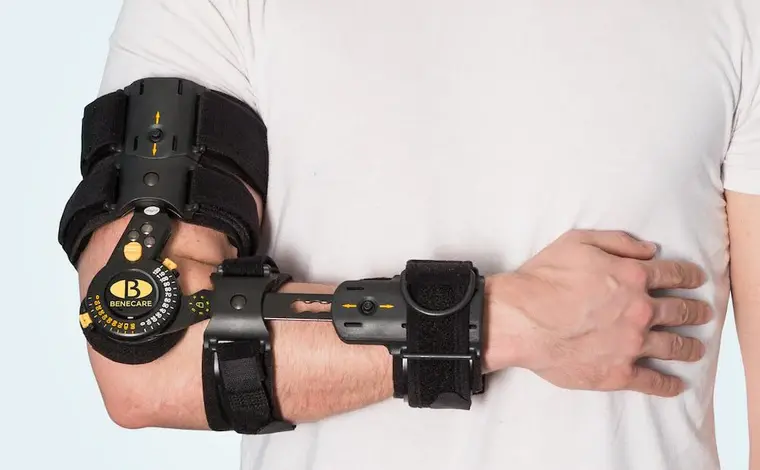What is a Kinetic Arm Brace: Understanding the Innovative Technology

In the world of sports and rehabilitation, technological advancements continuously strive to enhance performance, prevent injuries, and expedite recovery. One such innovation making waves is the kinetic arm brace. This cutting-edge technology merges biomechanics with wearable devices, offering a novel approach to supporting and optimizing arm movement.
In this article, we will delve into the world of kinetic arm braces, exploring the technology behind them, their applications, and the potential impact on athletes and individuals recovering from injuries.
The Genesis of Kinetic Arm Braces
Kinetic arm braces represent a marriage of biomechanical principles and modern technology. The goal is to create a wearable device that not only supports the arm but also actively enhances its movement.
The development of kinetic arm braces has been influenced by advancements in materials, sensors, and data processing, allowing for a more sophisticated and dynamic approach to support and rehabilitation.
How Kinetic Arm Braces Work
At the core of a kinetic arm brace are sensors strategically placed to capture and analyze the wearer’s arm movements. These sensors detect motion in real-time, collecting data on joint angles, acceleration, and other relevant biomechanical metrics. The information gathered is then processed through sophisticated algorithms, enabling the brace to respond dynamically to the wearer’s actions.
- Accelerometers and Gyroscopes
Most kinetic arm braces incorporate accelerometers and gyroscopes, allowing for the measurement of acceleration, velocity, and orientation of the arm. This data is crucial for understanding the dynamic nature of arm movements.
- Microprocessors
The collected data is processed by microprocessors embedded in the brace. These processors execute algorithms designed to interpret the wearer’s movements and adjust the brace’s support accordingly.
Adapting to Changing Conditions
The hallmark feature of kinetic arm braces is their ability to provide dynamic support that adapts to the changing conditions of the wearer’s movements. Unlike traditional braces that offer static support, kinetic arm braces intervene in real-time, dynamically adjusting the level of support based on the wearer’s needs.
- Variable Resistance
Some kinetic arm braces incorporate variable resistance mechanisms. For instance, as the wearer extends their arm, the brace may offer increased resistance to facilitate controlled and stable movement.
- Assistance during Rehabilitation
In rehabilitation settings, kinetic arm braces can assist individuals recovering from injuries. The brace can adapt its support to provide assistance during specific phases of the rehabilitation process, gradually reducing support as the wearer regains strength and mobility.
Performance Enhancement and Injury Prevention
Kinetic arm braces have found a prominent place in the world of sports, where performance enhancement and injury prevention are constant priorities. Athletes in various disciplines, from baseball pitchers to golfers, are exploring the potential benefits of incorporating kinetic arm braces into their training and competition routines.
- Baseball Pitchers
In baseball, the kinetic arm brace can aid pitchers by providing support during repetitive throwing motions. The dynamic support can help reduce the risk of overuse injuries and fatigue, allowing pitchers to maintain consistency and precision in their throws.
- Golfers
Golfers can benefit from the adaptive support offered by kinetic arm braces, especially during the crucial moments of the swing. The brace can assist in maintaining proper form, reducing the likelihood of injuries related to the repetitive and forceful nature of the golf swing.
- Tennis Players
Tennis players can utilize kinetic arm braces to support their arm movements during serves and strokes. The adaptive nature of the brace ensures that it responds to the dynamic demands of the game, providing optimal support without restricting motion.
Rehabilitation and Injury Recovery
Beyond sports performance, kinetic arm braces have shown promise in the realm of rehabilitation and injury recovery, forming a winning strategy for those seeking effective recovery solutions. These braces can be tailored to provide targeted support during specific phases of the rehabilitation process, offering a dynamic and personalized approach to recovery.
- Postoperative Support
Individuals recovering from arm surgeries or injuries may benefit from the adaptive support provided by kinetic arm braces. The brace can offer stability during the initial stages of recovery, gradually adjusting its support as the wearer progresses.
- Muscle Activation
Kinetic arm braces can be designed to encourage muscle activation during rehabilitation exercises. By providing resistance or assistance based on the wearer’s movements, the brace promotes targeted muscle engagement, facilitating a more effective recovery process.
Challenges and Considerations
While kinetic arm braces hold immense potential, there are challenges and considerations that must be addressed as the technology evolves:
- Customization
Achieving optimal performance with kinetic arm braces often requires customization. Ensuring that the brace is tailored to the individual’s specific biomechanics and needs is crucial for maximizing its effectiveness.
- Battery Life
The inclusion of sensors and microprocessors means that kinetic arm braces rely on battery power. Prolonged battery life is essential to ensure uninterrupted support during sports activities or rehabilitation sessions.
- Integration with Training Programs
For athletes and individuals undergoing rehabilitation, integrating kinetic arm braces into training programs requires careful consideration. Collaboration with sports trainers, physiotherapists and medical professionals is crucial for a holistic and effective approach.
Conclusion
Kinetic arm braces represent a paradigm shift in the way we approach arm support, whether for sports performance or rehabilitation. By seamlessly blending biomechanics with advanced sensor technology, these braces offer a dynamic and personalized approach to supporting arm movements.
The potential benefits for athletes seeking performance enhancement and individuals on the road to recovery are substantial. As the technology continues to evolve, kinetic arm braces are poised to become integral tools in the pursuit of optimized arm function and injury prevention, ushering in a new era of innovation in sports and rehabilitation.



